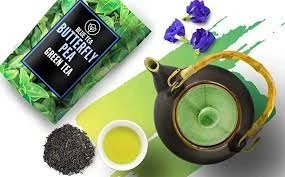Tea, one of the world's most cherished beverages, offers a diverse range of flavors, aromas, and health benefits. Among the countless varieties, green tea and blue tea (also known as butterfly pea flower tea) stand out for their unique characteristics and potential wellness perks. Both derived from different plants and processed differently, green tea and blue tea offer tea enthusiasts a delightful journey into the world of herbal infusions. In this article, we will explore the differences between green tea and blue tea, highlighting their flavors, appearances, health benefits, and why each should find a special place in your tea repertoire.
Green Tea: The Time-Honored Elixir
Green tea originates from the Camellia sinensis plant and is renowned for its minimal oxidation process, preserving its natural green color and abundant antioxidants. The leaves are plucked, steamed or pan-fired to halt oxidation, rolled, and then dried to create the signature appearance and flavor. The gentle processing method retains essential compounds, including catechins like epigallocatechin gallate (EGCG), which are potent antioxidants with a range of potential health benefits.
Flavor and Aroma: Green tea boasts a fresh and invigorating taste with mild grassy or vegetal notes. Some variants may have a hint of sweetness or floral undertones, depending on the tea leaves' origin and processing.
Health Benefits: Green tea has gained widespread popularity for its potential health benefits. The presence of EGCG and other antioxidants may aid in boosting metabolism, promoting weight management, and supporting cardiovascular health. Additionally, green tea's moderate caffeine content, coupled with L-theanine, contributes to enhanced focus, alertness, and improved cognitive function.
Blue Tea: Nature's Vibrant Elixir
In contrast to green tea, blue tea comes from the butterfly pea flower (Clitoria ternatea) and is naturally caffeine-free. The enchanting infusion exhibits a mesmerizing blue color, thanks to the high concentration of anthocyanins, powerful antioxidants responsible for the flower's striking hue.
Flavor and Aroma: Blue tea greets the palate with a mild, earthy taste, sometimes accompanied by subtle woody undertones. Its delicate flavor profile makes it a versatile herbal infusion, often enjoyed plain or enhanced with citrus or honey.
Health Benefits: Blue tea has garnered attention for its potential stress-relieving properties. The anthocyanins present in the butterfly pea flower have been associated with reducing stress levels and promoting relaxation. Additionally, this caffeine-free beverage offers a soothing experience without the stimulating effects of caffeine.
Visual Delights: One of the most captivating aspects of blue tea is its ability to change color. When combined with acidic ingredients like lemon juice or lime, the vibrant blue hue transforms into a delightful shade of purple. This visual magic adds an interactive and fun element to the tea-drinking experience, making it a fascinating choice for both adults and children alike.
Green Tea vs. Blue Tea: A Sip-by-Sip Comparison
Antioxidant Content: While both green tea and blue tea contain antioxidants, green tea is particularly rich in EGCG and other catechins. These antioxidants provide a more robust defense against free radicals, which may contribute to various health benefits. On the other hand, blue tea's anthocyanins offer unique antioxidant properties, providing their distinct set of wellness advantages.
Caffeine Content: Green tea contains caffeine, though in moderate amounts. This makes it suitable for those seeking a gentle energy boost without the jittery side effects. On the contrary, blue tea is naturally caffeine-free, making it an ideal choice for individuals who are sensitive to caffeine or prefer to avoid it altogether.
Stress-Relief Properties: Both green tea and blue tea are associated with potential stress-relief properties. Green tea's combination of caffeine and L-theanine can induce a sense of calmness and relaxation, whereas blue tea's anthocyanins offer their own soothing effect, making it an excellent herbal option for a tranquil moment.


